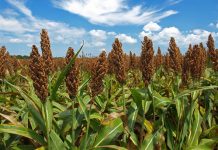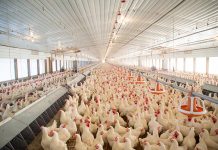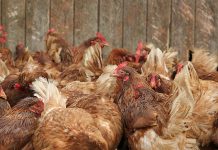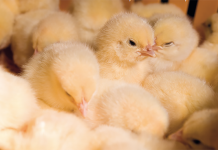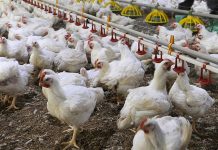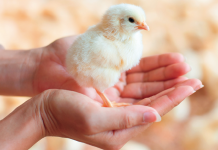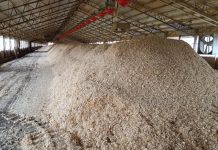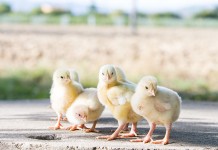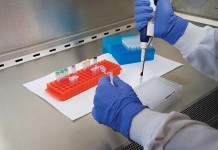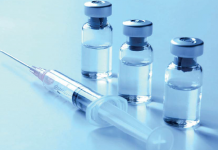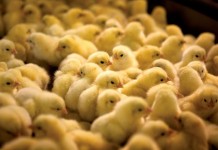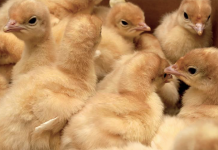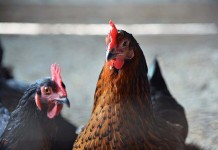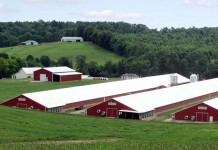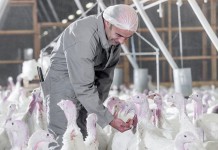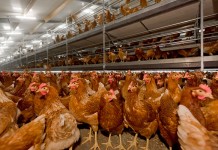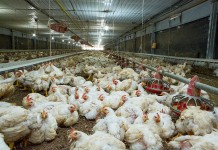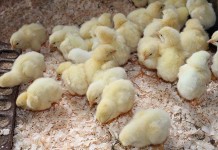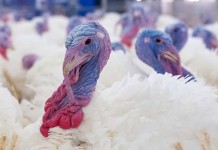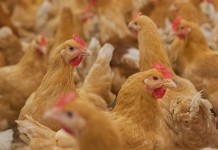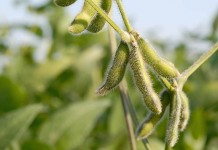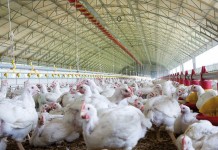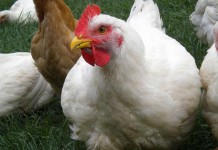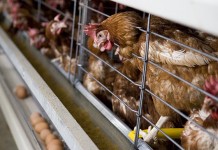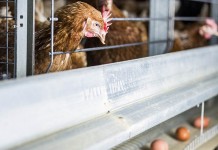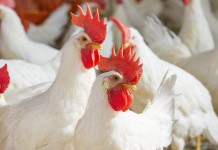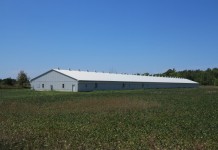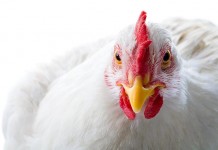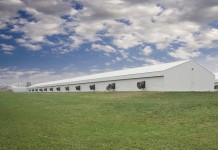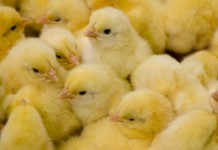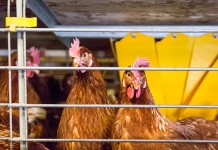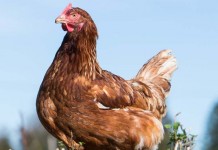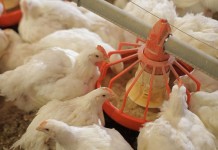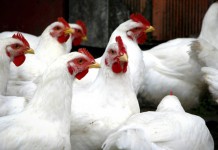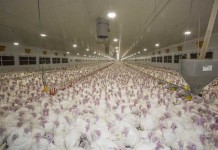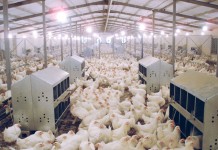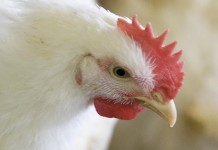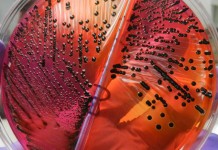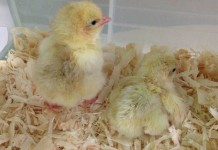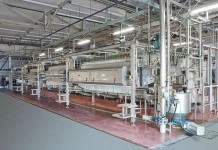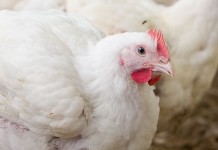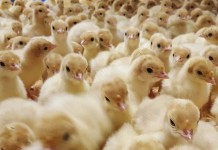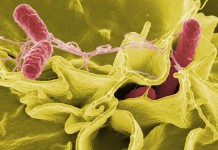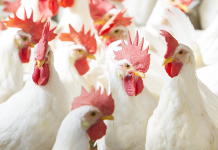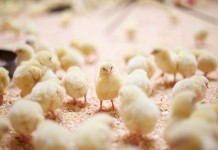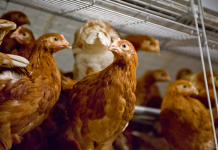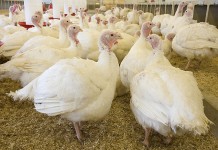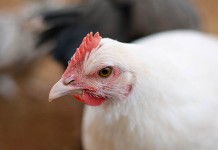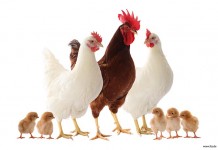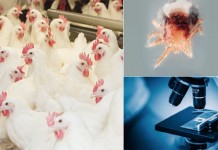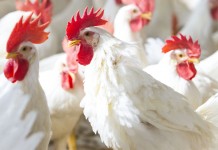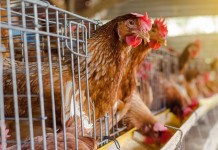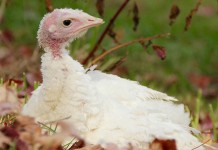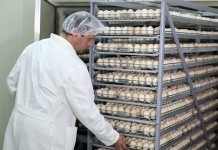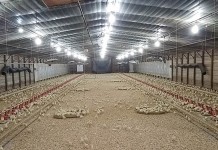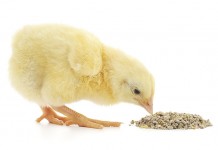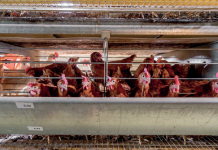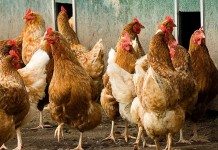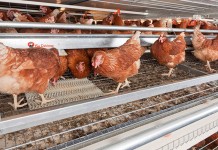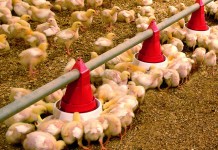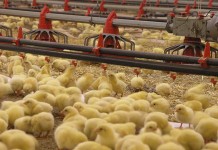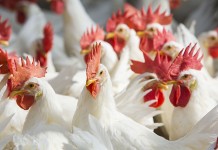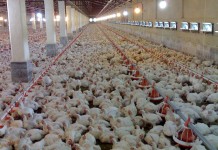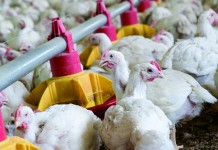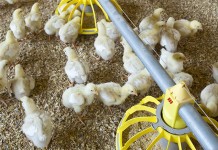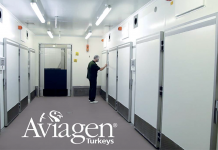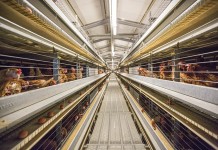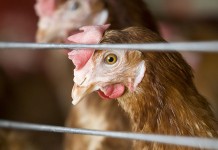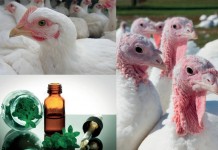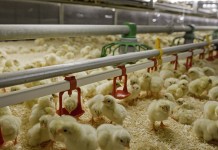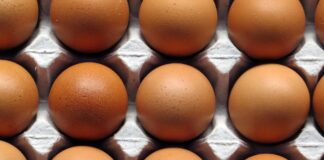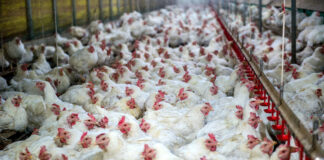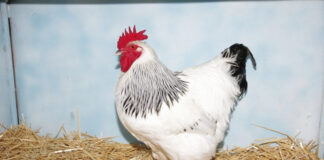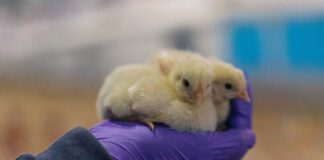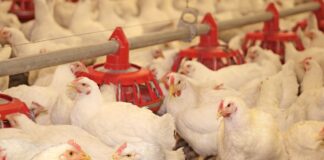Additivity of ileal amino acid values of sorghum with different protein sources
Sorghum is used widely in Australian poultry diets, primarily as an energy component. It is usually fed in diets that contain wheat but may...
The challenge of feeding modern broiler breeders
Broiler breeders are expected to produce about 150 chicks in 40 weeks of production and even though it is commonly believed that selection for...
Rapid in vitro antimicrobial screening assay against Campylobacter
Research was undertaken to adapt a multi-well antimicrobial assay as a fast and reliable method to screen large numbers of plant extract treatments against...
Biosecurity – practical tips to minimize the human risk of contamination
All poultry operations are under a constant threat from the ever-present enemy of disease and infection. It is imperative in all operations that we...
Active and passive Salmonella surveillance systems
Two surveillance systems have been established in France for the monitoring of antimicrobial resistance (AMR) in Salmonella enterica subsp. enterica isolated from the agro-food...
Jamesway’s Webinar talking about the Hatcher
The hatcher is often the forgotten sister of the incubator. Most presentations focus on getting everything right in the incubator, assuming that if the incubation...
Methods for recovery and quantitation of viral nucleic acids from broiler litter
There is a well-recognised problem with both the supply of broiler litter material in some regions, and with the disposal of spent litter. This...
Early introduction of whole-grain diets to broiler chickens
The main problem with introducing whole-grain diets (WGD) to newly hatched chicks is the kernel size and this has led to such diets being...
Increasing standardization in real-time PCR diagnostics
How to use it with a modular system and its benefit to laboratory throughput.
The IDEXX RealPCR™ real-time PCR reagents aim to provide a new...
Bacterin usage
A good vaccination program, along with proper flock management and biosecurity, plays a key role in the health and productivity of broiler breeders. The...
A practical approach to broiler breeder management in the absence of beak treatment –...
In the absence of beak treatment management strategies, which ensure appropriate bird development and growth and the provision of adequate environment and stimuli, which...
Re-stored turkey eggs outperform untreated eggs stored for 8 to 15 days by 7%
By using heat treatment during storage up to 14 days, as part of your standard hatchery practice, it is possible to gain up to...
A more sustainable poultry production
Researchers must find other approaches to food production and processing - and in particular for poultry production - using new technologies in conjunction with...
Exterior and interior strategies for rodent control
As the weather cools, rodents seek refuge indoors where there is easy access to food and water. Rodents are vectors for spreading disease, which...
Using sunflower meal in broilers with the addition of a carbohydrase complex
Sunflower seeds are extensively grown for oil production for human consumption. Therefore, a great amount of sunflower meal becomes available for use in feed...
Common global poultry welfare practices
A recent article by Hendrix Genetics detailed the creation and roll out of a structured poultry welfare program for all species offered by the breeding company.
The...
Dietary non-phytate phosphorus levels for laying hens in the last phase of lay
The phosphorus (P) requirement of laying hens is an area of on-going debate and it is a factor that contributes to hen performance and...
Performance benefits of probiotic and protease in broilers subject to Eimeria challenge
Consumer pressure and government regulations are driving US poultry industry to remove antibiotic growth promoter (AGP) from poultry production.
Nutrition program including feed additives is...
Incubation temperatures influence muscle growth and energy in broiler embryos
In ovo embryogenesis in broiler can be modulated by alteration of external factors, like the incubation temperatures, as shown in several publications.
Embryonic myogenesis in...
Antibiotic-Free turkey production
The production of turkeys without the use of antibiotics is an increasingly common goal across the globe due to the focus on antimicrobial resistance....
Aviagen slower-growing breeds get seal of approval from key European welfare schemes
Europe is experiencing an increase in demand for slower-growing breeds. The momentum of this poultry market sector is likely to follow on an upward...
Replacing soy in broiler diets. Effect on performance, carcass yield and cost of production
The objective of the present study was to evaluate the effect of replacing soybean meal (SBM) in broiler diets on performance, carcass quality and...
Effectiveness of a double choice test to assess dietary taste preferences in broiler chickens
Investigations into the taste system of chickens can help to improve poultry feeding strategies. However, a comprehensive study on dietary taste preferences for broilers...
On-farm control of campylobacter
Campylobacteriosis, primarily caused by the consumption of contaminated chicken products, accounts for the majority of food poisoning cases in Europe and many other developed...
Modification of the chicken intestinal epithelial physical barrier in poultry by dietary factors
The intestinal epithelial physical barrier is the most critical element of maintaining an intact intestinal barrier and made up of a layer of columnar...
Novel Approach Improves Poultry Welfare by Reducing Stress on Chickens
MSD Animal Health (known as Merck Animal Health within the United States and Canada) recently announced the launch of EXZOLT® (fluralaner), the first systemic...
Evaluating hen behaviour and physiological stressors during Ventilation Shut Down
USPOULTRY announces the completion of a funded research project at North Carolina State University in Raleigh, N.C. in which researchers provided insight on using...
Comparison of wheat and maize-based diets on growth performance and meat quality of broiler...
Maize and wheat are a major source of energy in broiler diets. Generally, wheat-based diets are offered to broiler chickens in Europe, Australia and...
Update on Infectious Bronchitis in the United States
Infectious bronchitis infections continued to increase this year in the Ontario broiler, broiler breeder and layer sectors.
Infectious bronchitis virus (IBV) can be spread by...
BBSRC launch the Agriculture and Food Security Strategic Framework
The new framework identifies the key research and innovation priorities of the Biotechnology and Biological Sciences Research Council.
The new BBSRC’s Agriculture and Food Security...
Monitoring of IBV circulation and prevalence
Infectious bronchitis (IB) is one of the most common viral diseases in chicken production worldwide and IB virus (IBV) is considered the most contagious...
Enhancing biosecurity using flow analysis and Danish entry concepts
The term Danish entry is commonly used to describe entryways to livestock buildings that help people enter barns in a relatively bio secure way...
The effects of in-ovo feeding
In-ovo feeding is a key issue in poultry. The embryonic and immediate post hatch developmental period represents a significant phase in attaining quality broiler...
Challenges in longer laying cycle. Stabilizing egg quality
In the past 50 years, selection, initially at the breed level and then using quantitative genetics coupled with a sophisticated breeding pyramid, has resulted...
Effects of early enrichment on range use in free-range laying hens
Free-range laying hen production systems are perceived to be preferable for hens’ ethological needs. However, not all hens use the range daily with some...
Field experience on the use of probiotics in chickens and turkeys
Probiotics have been used for several years in an attempt to improve intestinal health. Recently, microbial products have been extensively studied as supportive treatments...
On free amino acids – Their role in starch and protein digestive dynamics
The quantity of glucose and amino acids absorbed from the small intestine is a function of dietary concentrations, feed intakes and digestibility coefficients. Moreover,...
Future of Blackhead Disease in poultry
A turkey health survey of US veterinarians in turkey production ranked blackhead position #13 (#11 prior year) compared to #22 in 2006; the survey...
A practical approach to broiler breeder management in the absence of beak treatment –...
In the absence of beak treatment adhering to proven and agreed best practice management practices is key. The roles of good stockmanship and promoting...
Broilers perform better with intermittent lighting programs
Roles of certain parts of the digestive tract of chickens seems to have been lost with the evolution of time and commercial practices. Gizzards...
Ability to detect Salmonella vs. Salmonella-Free in poultry processing
Poultry are sampled often for Salmonella during growout on the farm and throughout the processing plant. While on farm sampling is not currently a...
Immediate post-hatch nutritional restriction in broilers
The effect on broiler muscle development and occurence of intramuscular fat.
Neonatal nutrition and immediate post hatch nutritional restriction represent an important facet of broiler...
Meyn quality slaughtering
MEYN is the reliable and committed partner of renowned poultry processing companies in over 90 countries worldwide, with people having the right professional skills...
Energy-efficiency in pre-conditioning inlet air for setters and hatchers
Hatcheries are found in a variety of climates, from the hot, humid tropics of South East Asia to hot, arid zones in the Middle...
Probiotics as an alternative to antibiotics for treating lameness in broilers
The pathogenesis leading to a form of lameness known as bacterial chondronecrosis with osteomyelitis (BCO) appears to be initiated by mechanical microfracturing of susceptible...
Turkey hatcheries – The past 25 years and the future of single-stage
A quick time travel back to a turkey hatchery in 1992 might show you a frazzled hatchery manager frantically trying to get eggs trayed,...
Isoquinoline alkaloids lower the prevalence of salmonella Heidelberg in broiler chickens
Worldwide, tens of millions human cases are reported every year for salmonellosis. This makes it one of the most common foodborne diseases, which can...
High levels of cottonseed meal supplemented with composite microbial enzymes
Effects of cottonseed meal supplemented with composite microbial enzymes on broiler chickens.
Soybean meal (SBM) is the premier plant protein source used by the poultry...
Integrated Microfluidic Device for rapid Avian Influenza virus capture
Rapid detection of avian influenza virus (AIV) is highly desirable during outbreaks or routine AIV surveillance.
In this project, the preliminary results in developing a...
Quick molt diets and programs
Induced molting is a process conducted by many commercial egg producers to extend the productive life of the laying hen. The main objective of...
Turkey breeding – Where from, Where to? – Domestication of animals was a major...
All species of today’s domestic plants and animals followed an analogous pattern of multi-generational change influenced by humans. The modern populations of turkeys followed...
The Omics revolution – Implications for animal production
What does Omics mean?
Omics is a term that refers to the recently developed high throughput technologies that include genomics, functional genomics (transcriptomics), proteomics, and...
Selection for persistency and profitability in layers
Prof. Dr. Rudolf Preisinger, Chief Technical Officer at the EW Group, held a presentation on the selection of Lohmann’s layer lines for the traits...
Hatcheries data collection and analysis
Hatcheries collect large quantities of data to monitor performance and to make sure equipment are operating within set operating limits.
These data are a valuable...
Characterizing litter mite communities. Applications of DNA barcoding for management strategies
The use of DNA barcoding can facilitate rapid biodiversity assessments of fastidious taxa - litter mite communities - by delineating species using molecular operational...
Scientifically validated results to raise poultry production profitability
The Poultry Science Association 2017 Annual Meeting took place in Orlando, Florida on July 17-20. Being the most prestigious scientific event for poultry in...
Practical applications of nutrigenomics in poultry nutrition
Novel molecular techniques such as microarray technologies have spurred the development of the field of nutrigenomics.
Using microarrays to evaluate gene responses allows us to...
Better than alternatives to antibiotics
Many poultry flocks require antibiotic treatment, if not every cycle, regularly. Antibiotic alternatives are in great demand, especially in the context of dysbiosis and...
The relationship between sperm function and diet – Toms are what they eat
It is well known that cryopreserved semen could be used to regenerate commercial or research poultry lines; however, fertility rates from poultry semen frozen...
Separating welfare facts from fiction
It has become a confusing market for customers to decipher which technologies offer the best welfare-friendly solutions for their animals. How do you separate...
Healthy water, healthy birds
Since birds consume as much water as feed providing a clean, safe and sanitized water supply is crucial for assuring modern poultry flocks perform...
Limiting embryonic overheating during incubation
Embryonic overheating can represent an issue for incubators. For many things in life, a change in temperature of +0.5°C is hardly noticeable. However, for...
Measurement of true ileal calcium digestibility of meat and bone meal for broiler chickens
Currently, there is a move towards the use of digestible phosphorus (P) in diet formulations for poultry due to P excretion into the environment...
How Xylanase can improve performance of a broiler diet
Whilst xylanase rich NSP-enzymes are used consistently in wheat based diets the question remains whether the positive response seen can be ascribed solely to...
Impact of investment in Hendrix Genetics’ breeding and testing program
With the upcoming release of the new performance standards for Hendrix Genetics’ laying hens, it is important to examine factors contributing to the genetic...
Visual identification of potential feather pecking
Feather pecking behaviour is common in floor-housed laying hens a behavior, which is positively associated with developing feather pecking habits.
It has been suggested that...
Laying hen nutrition for optimizing egg production and quality
Hen nutrition is important; during the initial period of pullet rearing (<45 days of age), small particle size obtained by grinding of main cereals...
Automated assessment of health and welfare in commercial broiler chicken flocks using optical flow
Assessing the health and welfare of growing broiler chickens is mainly done post mortem, using measures taken at the slaughter plant (% birds with...
Managing coccidiosis in birds raised without antibiotics
For poultry producers to make a profit they must have healthy, uniform sized birds, make sure there are no real or assumed human health...
The Salmonella initiative
An enduring challenge and reputational issue for the egg industry is caused by the presence of Salmonella enterica serovars (particularly some Typhimurium serotypes), which...
Incubation temperature and how it influences chick hatch time and bone ash
With commercial broilers spending up to 30% of their lifespan in the egg, incubation temperature has been linked to some leg weakness issues.
The recommended...
Evaluating phosphorous equivalency of phytases
The use of exogenous enzymes in non-ruminant nutrition is a valuable tool to increase digestibility and therefore spare the inclusion of expensive nutrients whilst...
Measurement of energy utilization in chickens
Although corn prices have dropped from historic highs in the past years, energy continues to be one of the driving costs in poultry feeding....
Using more bioavailable sources of trace minerals pays off
A study of broiler breeder performance was conducted using three separate minerals programmes. The objective was to determine if productivity could be maintained at...
Influence of feed form and particle size on the performance and nutrient utilisation of...
The present experiment was designed to examine the influence of feed form and particle size in maize-based diets on the performance and nutrient utilisation...
SPIDES, short periods of incubation during egg storage
Why SPIDES is so important in incubation? If hatching eggs are stored for more than a week before being set in an incubator their...
Housing systems in laying hen husbandry- First part
A status report
This analysis is an abridged version of a report which the author prepared for the International Egg Commission (IEC) in London, UK.
In...
In vivo digestion of GM proteins in laying hens
Despite all of the positive effects of modern technologies to improve corn and soybean yields, the consumer often has a different perception of the...
The role of feed additives in the protozoal diseases in poultry
Coccidiosis and histomoniasis are economically significant diseases in chickens and turkeys. Management, vaccination and medication are key tools in the control of these diseases...
How to reduce antibiotics in broiler production?
There is an increased awareness recently in relation to the sensible use of antibiotics within poultry and livestock production. When looking at broiler production,...


